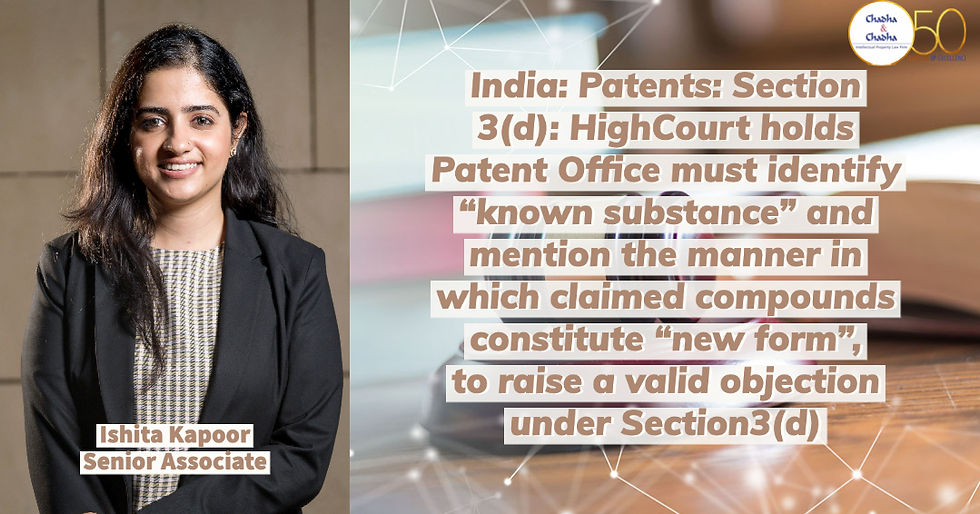India: High Court Holds Patent Invalid, Gives A Nod To Manufacture And Launch Chlorantraniliprole

Introduction:
On November 14, 2022, the Hon’ble High Court of Delhi in the case of FMC Corporation & Ors. vs GSP Crop Science Pvt. Ltd.[1], allowed GSP Crop Science to launch the manufacture and sale of Chlorantraniliprole (CTPR), and dismissed the interim injunction application of FMC.
Brief Facts:
The suit was instituted by FMC Corporation, USA and its two group companies i.e., FMC Agro Singapore Pvt. Ltd. and FMC India Pvt. Ltd. (hereinafter referred to as the “Plaintiffs”) seeking inter alia, an injunction against GSP Crop Science Pvt. Ltd. (hereinafter referred to as the “Defendant”) from utilising the method claimed in IN252004 (hereinafter referred to as the ‘suit patent’) titled “Method for Preparing Fused Oxazinones from Ortho-Amino Aromatic Carboxylic Acid and a Carboxylic Acid in the presence of a Sulfonyl Chloride and Pyridine”, i.e. the patent for manufacturing and selling CTPR.
The suit relates to an intermediate stated to be used in the manufacture of one of the products sold by the Plaintiffs i.e., Chlorantraniliprole (“CTPR”), which is an insecticide product. The Plaintiffs claimed to have acquired knowledge of an application filed by the Defendant before the Central Insecticides Board and Registration Committee for registration under Section 9(3) of the Insecticides Act, 1968 for Technical Indigenous Manufacture of CTPR. Subsequently, the Defendant obtained the said approval to manufacture CTPR in August 2022.
Based on analysis of the report submitted by the Defendant to the Ministry of Environment, Forest and Climate Change, Government of India, Plaintiffs alleged that the manufacturing aspects disclosed by the Defendant are identical to the process/method covered by the suit patent in terms of the starting materials, products and coupling reagent, which falls within claim 1 of the suit patent.
Contrary to the Plaintiffs’ averments, the Defendant contended that the process of manufacturing CTPR using benzoxazinone intermediate is in public domain since August 13, 2022, in view of the disclosure claimed in the product patent IN213332 (IN’332) and the product patent IN201307 (IN’307). Further, it was argued that the suit patent is prima facie invalid due to prior claiming[2] as it is anticipated by IN’332.
The Defendant alleged that the Plaintiffs have repeatedly filed multiple suits asserting different intermediates, and processes against various entities, only with a view to prevent the launch of CTPR in India, and are guilty of evergreening the CTPR exclusivity.
It was further alleged that the patent was obtained on false suggestion and mis-representation (non-compliance with Section 8 of the Act). More notably, the Plaintiffs’ contentions of “commercial success” (in the Rejoinder) and admission of non-working of the suit patent in Form-27 were completely contradictory. Whereas, it appeared that the invention claimed in the suit patent has not been worked anywhere globally, let alone in India.
Analysis and Findings of the Court:
Having considered the various litigations initiated by the Plaintiffs appertaining CTPR and submissions put forth by the parties, the Honorable Court made the following observations:
· The Honorable Court was emphatic on that point that the instant suit appeared to be a classic case as warned by the Supreme Court in Novartis AG vs. Union of India, wherein the Plaintiffs seek to search for Defendants who could be sued in order to prevent commercial launch of the CTPR product in some manner, even though the product and process patents have expired.
· The Court emphasized that multiple patents can be filed for different aspects of a particular product, if the tests for novelty, inventive step and industrial applicability are satisfied and the inventions are patentable. However, serial patenting in order to “Evergreen” a particular monopoly, is not permissible.
· The Court also noted that where an invention has not been worked for more than 19 years (Form 27 data) and the term of the patent has nearly expired, it raises doubt as to the industrial applicability of the suit patent itself.
· Moreover, upon minute analyses of the processes claimed in the suit patent and IN’332, it was observed that the same are almost identical, though in suit patent the claims are couched in broader and generic manner, the differences are merely superficial. It was thus held that the suit patent was hit by prior claiming and is prima facie invalid owing to the disclosures made in the complete specification and claims of IN’332.
· Apart from the vulnerability of the suit patent due to prior claiming, the Plaintiffs were held to be prima facie guilty of supressing material facts and misleading the Court as well as the Indian Patent Office, due to gross misrepresentation in the status of a few corresponding applications (Form 3).
Therefore, the application for seeking an interim injunction was dismissed with costs of USD 2,550 and the Defendant was permitted to launch the manufacture and sale of CTPR, on the condition that an account of sales is maintained and produced on a half-yearly basis, during the pendency of the suit.








































Commentaires